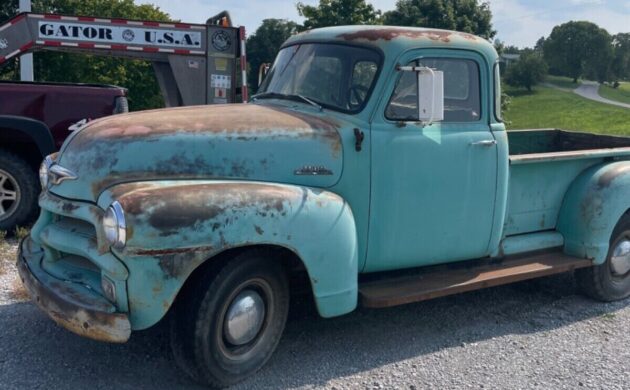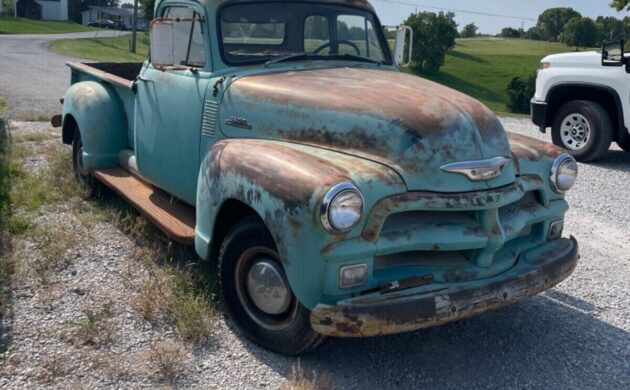The Advance-Design Series of Chevrolet pickups were the first all-new models after World War II. They would remain in production from 1947 to 1955. Over at GMC, the same trucks were known as the New Design Series. The 3600 was the ¾-ton edition which had a rated hauling capacity of 1,500 lbs. This is a 1954 rendition of the truck that the seller acquired a few years ago from the previous owner’s estate. It doesn’t run, but the motor does turn freely, and the overall truck has a fine coat of patina. Located in Mount Olivet, Kentucky, this old workhorse is available here on eBay where $9,001 is the current ante.
Unlike today where Ford is the dominant pickup manufacturer, Chevy’s Advance-Design trucks were the sales leader throughout its production run. Changes were minimal from year to year, such as the availability of an in-dash radio in a pickup for the first time. Or the addition of vent windows in the doors for better ventilation. And you could order an optional 4-speed Hydra-Matic automatic transmission in later years, which we assume is rare and the seller’s pickup has one.
As the story goes, the husband of the lady the seller bought the truck from used it regularly up until the time he passed away. But it must have sat for a while after that and hasn’t run since. The 235 cubic-inch inline-6 and the automatic tranny are both said to be original to this vehicle. There is some confusion with the title as it lists this as a ½ ton pickup, but the seller confirms it’s a ¾ ton 3600.
The paint is original and the patina it’s collected over the years looks impressive. If there is no see-through corrosion to repair, perhaps the solution is to put some clearcoat over the current finish and leave it looking the way it has for the past several years. After all, they’re only original once.







Chevrolet had the Powerglide transmission in 1953. Any other type of automatic transmission, was not available from Chevrolet for several more years. So, the stated transmission in this ad, is not original. Or the post is just incorrect.
1954 – 1955 Chevrolet Advanced Designed Trucks were also offered with a Hydramatic Transmission. They were 4 speed also.
GM’s 4 speed Hydramatic was available for Chevrolet pickups beginning in 1953 and running through the 1950s.
Drag racers found a loophole in the NHRA rulebook that allowed Chevrolet sedan deliveries to run the 4 speed Hydramatic even though they were never factory installed in any passenger cars. The sedan deliveries were advertised only as trucks and displayed only in truck brochures. Chevy sedan deliveries ruled the lower stock automatic classes untill NHRA closed the loophole in the early 70s.
Probably is an accurate depiction in light of further research..
Chevrolet had the PowerGlide transmission in 1950. It shifted from low to drive, starting in 1953. Powerglide before 1953, did not shift automatically. You could start out in drive (slow acceleration), or you could put tran in low and shift it manually, to drive. This was the first auto tran from Chevrolet. No other model auto transmission from Chevrolet for a few years yet. Early PowerGlides were cast-iron. Chevrolet started making aluminum case PowerGlides in early 1960’s. PowerGlide transmission would bolt onto a Chevy inline 6 engine.
My grandfather was a Chevrolet mechanic for many years. The PG, though primitive, was very durable.
PowerGlide transmission was a 2-speed, low and Drive.
BTW: Castaway doppelganger truck. Remember the Hanks movie, the welder artist’s truck? Castaway 2 window closed perhaps. Hanks is more apt to play Rip Van Winkle at this stage. Great old truck that deserves to be preserved.
Steve you are correct when it comes to automobiles but Bill is correct according to two sources online the truck was available with both a 3 or 4 speed manual or a 4 speed Hydramatic transmission. See the link I attached for clarification. I to look it up, I didn’t realize they made a 4 speed Hydromatic transmission back then either. First I have ever seen or heard of.
Regardless this would be a very cool old truck to preserve in its original as much as possible.
https://en.m.wikipedia.org/wiki/Chevrolet_Advance_Design
The ’54 and first series ’55 GMC and Chevy pickup was available with a HydraMatic transmission. Fairly rare as far as I know because it was an expensive option. Trucks were for work then and every working man knew how to drive a stick….
Also on the Advance Design trucks, a long bed was available on the GMC half ton, but on the Chevy the half ton was only the short bed. Had to get a 3600 3/4 ton for the long bed(8′). This one looks like the 6 1/2′ short bed….
GMC trucks had a automatic first in 53 then Chevy in 54
yes. Automatic trucks were EXTREMELY rare in the 50s and into the 60s. My dad was in the construction business and I remember contractor friend of his who had a disability who had a ’57 or so GMC dump truck (not sure of the series in those days–would have been the equivalent of a Ford F-600) with a Hydramatic because he was physically unable to use a clutch. I think that was the only truck I ever saw with an automatic until the late 1960s especially starting with model year 1967 when both Ford and GM (but especially GM) started offering trucks that were more car-like in ride and interior appointments.
GM’s 4 speed Hydramatic was available in Chevrolet pickups beginning in 1953 and continued to be available through the 50s. Drag racers found a loophole in NHRA rules that allowed the 4 speed automatic to be used in Chevrolet sedan delivery’s because they were listed as trucks and only featured in truck brochures. Chevrolet never in stalled the Hydramatic in any passenger cars, but the sedan deliveries were allowed to race them and ruled the automatic stock classes until NHRA outlawed the loophole in the early 70s.
The writer claims that Ford is currently the dominant pickup manufacturer. This is true only if you consider the General Motors products, Chevrolet and GMC, as differing from each other. Yet those trucks are virtually identical. When the two marques are combined, General Motors produces considerably more units than Ford. In 2022, GM sold 882,000 units versus Ford’s 654,000.
https://www.motor1.com/features/629701/best-selling-trucks-2022/#
My bets are on Ford taking over the crown by 2035…
Yeah, it really comes down to how you define “manufacturer.” Even the automakers themselves have moved away from the term “make” and towards the term “brand” as a tacit admission that the term “make” has become rather obsolete. A Chevy and a GMC are not really different “makes” as they are made by the same folks. It wouldn’t surprise me to learn that they are even made on the same production lines with one truck getting a GMC grille and the next one getting a Chevy grille, etc. (I know it’s a bit more complicated than that.) But there is a lot more difference between a Ford F-150 and a Ford F-250 (they are pretty much completely different trucks) than between a Silverado 1500 and a Sierra 1500. But Ford hangs onto that “F-Series” moniker because it allows them to count all the F-150 and Super Duty sales together. That being said, Chevy and GMC are also counting their HD sales along with their 1500s. A bit surprised that GM never seems to point out that they actually sell more full-size trucks than Ford does, but I guess they don’t want to openly admit that Chevy and GMC are pretty much the same truck.
I have not done a GM plant tour in many many years but I can tell you in the mid 1960’s they absolutely came down the same assembly line at the old GM plant in St. Louis. I remember commenting to the tour guide when I was in grade school doing a GM plant tour for our school field trip. We went there twice. There were a lot more Chevy trucks than GMC’s but you would see 5 or six Chevy’s and then a GMC. I think the last time I was there was 67 but I bet it hasn’t change as for as coming down the same line.
Appears that the sale has ended. Even with a $100.00 starting bid, no one bid.
I checked with the seller the other day and he said it sold. He didn’t offer the price or any other info.
I bought a ’54 GMC 1/2 ton many years ago thinking it had a 235 ci engine. Not so, had a 248 ci GMC. Found this out when I had to replace the head. Not as easy to find parts for as the 235. Also the truck was positive ground. Those 50’s GMC were truly different from the Chevy, not like todays models.
Yes, it seems the differences were more under the skin than on the outside. GMC had unique engines, including their own V6 in the 60s, which was totally a truck engine and had nothing to do with the Buick V6. The GMC V6 was NEVER available in any Chevy truck, to the best of my knowledge. They even developed a V12 gas engine for heavy trucks from that V6. I miss the days when the GM divisions were actually different from each other and not just “brands” or nameplates as they are today. I think the market was much better served having what amounted to six unique, individual makes, even if they were all subsidiaries of one parent company–of course it made economic sense to share parts like windshields and door handles, but the makes were different where it really counted, like engines, transmissions and chassis. And the divisions were run separately and fiercely competed with each other where their markets overlapped–I think the consumer was well-served by that competition and the additional choices it provided. Today, GM is a pale shadow of what it once was and the individual make names mean little. They might as well be honest and just call everything they make “GMC.”
I remember those days, I think it was about 1967 when GMC and Chevy trucks pretty much started sharing drivetrain. I think all the way back into the late 1940’s they shared sheet metal. The GMC started using a pressurized oil system I believe a year or more before Chevy as well. We had a couple of GMC’s in our company fleet with the V6 engines, a 305 in a pickup and a 351 in a medium/HD truck. Both were 1966 model year. I replaced the 351 more times than I can remember. Carried to much weight and pushed to hard.
From what I remember they had six variants of V6’s, one V8, and one V12. From what I just checked out these engines were produced from 1959 through 1974. I did not find what years they stopped using them in pickups or which models carried into the 1970’s. I do remember seeing Chevy V8’s in late 1960’s and early GMC trucks. I remember our 1966 GMC was a 3/4 ton truck that had a 305V6 a 4 speed manual transmission, and coil spring rear suspension. This is generalized information so I’m sure more info is available if someone wants to dig deeper.
305 cu in (5.0 L) V6
351 cu in (5.8 L) V6
379 cu in (6.2 L) V6
401 cu in (6.6 L) V6
432 cu in (7.1 L) V6
478 cu in (7.8 L) V6
637 cu in (10.4 L) V8
702 cu in (11.5 L) V12
I bet that 478V6 was torque monster.
My brother once owned a 1950 Olds 88 with a four-speed Hydramatic, so yes, they did exist.